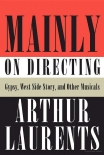Mainly on Directing, Arthur Laurents [best books for students to read TXT] 📗

- Author: Arthur Laurents
Book online «Mainly on Directing, Arthur Laurents [best books for students to read TXT] 📗». Author Arthur Laurents
Who is responsible for the smoke and mirrors? Varies. Who has the bigger name, the director or the choreographer? Who wants the responsibility? Who knows how to inspire designers? Who is more creative? That is the single most determining factor, as it should be. The single most important practical question is: who stages the songs—the director or the choreographer, or both in tandem? Even should it be the latter, it still will be who is first among equals, director or choreographer?
A bravura song in Cage called “A Little More Mascara” provides a perfect example of the difference between a director's approach and a choreographer's approach in the staging and performance in comparing the original production and the recent revival. In the original, Albin (George Hearn at his best) is sitting in his sad cubicle of a dressing room. The dressing room is in midair, isolating Albin, visually making him lonely and alone. He sits at his dressing table in a corset with the “false boobs” he sings about mournfully, without makeup (George's white-on-white skin helped), an aging queen staring into the mirror at his wrinkles. His star as Zaza, drag Queen of Riviera Cabaret, is flickering out. As he sadly sings, the only thing that keeps him going is to “put a little more mascara on.” As he begins making up, he does just that: light base, eye shadow, false eyelashes, mascara. Brush on a touch of rouge, a little more mascara, lipstick, a little more mascara. Pull on a wig; pull up a gold-sequined dress hidden by the skirt of the dressing table; fasten it via a rhinestone collar (and Velcro); throw a feather boa around his powdered shoulders; step out from behind the dressing table, and lo and behold! There, on the top of a lighted stairway that slid out to greet him with an archway of twinkling lights coming down to frame him, there was Zaza! Undiminished, triumphant, Queen of the Riviera again! It was a highly theatrical staging and an emotionally moving performance.
The steps necessary to transform an aging old queen into a glamorous cabaret star before the eyes of the audience were worked out with mathematical precision. The application of each piece of makeup, the wig, the dress, the boa—all were carefully timed to the music. George rehearsed and rehearsed so that all the technical parts of the song didn't get in the way of what made it emotionally moving and finally thrilling: his acting, his performance. Albin started the song aging, discouraged, disheartened; the life force emerged and he began to get stronger, younger—transformed himself from a used-up has-been to a glamorous, invincible star. The song needed both elements to work, and it got them.
In the revival, Zaza—he was never Albin in “Mascara,” only Zaza—also began in midair, on a platform in a glistening black gown against a black curtain. When he sang of putting “a little more mascara on,” the involuntary question was, where? There wasn't conceivable room for more, or for a millimeter more makeup of any kind: he was slathered in it, it was inches thick, it looked heavier than the dress. Nor was there any attempt to progress from the “ugly duckling to a swan” the lyric described. The change he did make was to rip off the glistening black gown and—surprise?—a glittering black-sequin gown underneath. What, then, was the song about? A change of costume. A camp number by just another drag queen, not a musical soliloquy by an aging artist determined to keep going. The choreographer responsible for the staging won the Tony that season.
The difference between the two approaches reflects the difference in the Broadway theatre at the time of each production. The twenty-first-century Broadway theatre shows Hollywood's influence—not just on musical theatre, on all theatre. The play is no longer the thing; the star is the thing. Musicals? Styled for the same audience as the multimillion-dollar blockbuster—one with neither heart nor mind. The Broadway blockbuster favors frenetic musical numbers with a thinly satirical connective tissue and a presumably saleable, presumably original element—a zoftig drag leading lady in Hairspray, for example. Actual originality, with a very occasional exception like LoveMusik, is found in transfers from Off Broadway like Spring Awakening. But even there, the originality is in the musical staging and the powerful rock music; the story, shocking in its long-gone day, is banal today, the bungled abortion is predictable, and the moaning that follows is merely sentimental slop to the new young audience rocking in its expensive seats to the music that brought it there. The heart and mind were not affected. Nor were they affected by the revival of La Cage aux Folles.
Question: over two decades earlier, did the Broadway theatre seek to touch the heart and provoke the mind? Often. Did the original production of Cage?. Yes, the director surely did. Did he achieve what he wanted?
No, judging by the sneers of the activist gays during the first weeks of what was an enormous, unexpected hit. They loudly complained the show was vanilla, white bread, and timid, though beautiful to look at. (A year later, at an expensive fundraising gala dinner, the Human Rights Campaign, a premier gay organization, awarded Jerry, Harvey, and me their premier prize. Well, they needed names to sell the expensive tables.)
The view from the stage of the Palace Theatre differed from that of the denigrators. The Cagelles in the opening number looked out and saw men burying their faces in their programs rather than look at other





Comments (0)